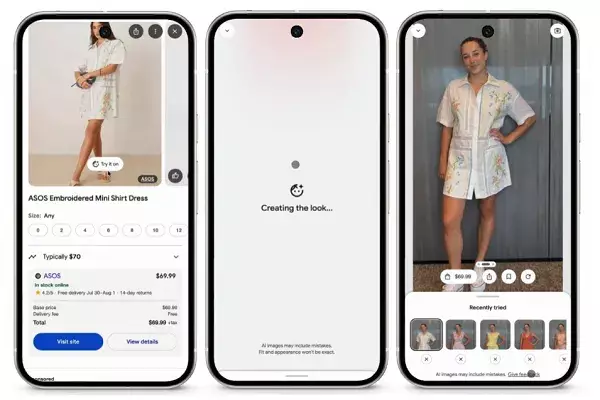In an era where digital convenience is paramount, Google’s recent innovations in AI-powered shopping tools mark a significant leap toward a more personalized, efficient, and engaging online retail experience. Rather than simply adding incremental features, these developments address core challenges consumers face—uncertainty about fit, price fluctuations, and selecting products that match their unique style. With these tools, Google positions itself as a pioneer in reshaping how we discover, try on, and purchase products online, making the process feel more intuitive and less fraught with doubt.
One of the most notable advancements is the virtual try-on feature that utilizes artificial intelligence to simulate how clothing will look on each individual. Previously confined to early beta testers, this feature now opens to the wider U.S. market, signaling Google’s confidence in its accuracy and usability. Imagine uploading a full-length selfie and instantly visualizing how a specific pair of pants or a dress fits your body shape—this marks a paradigm shift from static product images to dynamic, personalized previews. The potential here is enormous: reducing returns, increasing customer satisfaction, and bridging the perceptible gap between online and in-store shopping.
This innovative function empowers users to experiment with different looks, save preferred combinations, and even share them with friends for opinions—all within search results. While the actual correctness of these previews depends heavily on the sophistication of the AI’s matching capabilities, they promise to significantly streamline decision-making. Consumers will no longer need to rely solely on size guides and wishful thinking when shopping online; instead, they can see a virtual rendition of themselves in various styles, boosting confidence and satisfaction. Still, the real test will be how well these virtual try-ons match the look and feel of real-world products once they arrive—something only time and extensive user feedback can determine.
Smart Price Tracking and Deal Hunting Made Simpler
A common frustration in online shopping is not knowing when prices will drop or if a current deal is truly the best available. Google’s upgraded price tracking tools aim to eliminate this dilemma. Now, when users activate ‘track price’ for a product, they can specify preferences such as size, color, and target price, transforming the way consumers hunt for bargains. Instead of manually monitoring countless pages and listings, shoppers receive tailored notifications whenever the product hits the desired price point or a sale aligns with their preferences.
This feature leverages Google’s extensive shopping graph—an AI-powered map of products and prices from across the web—to deliver real-time alerts. It’s a game-changer for deal hunters and budget-conscious buyers, especially during peak sales events. By automating the process of finding the best prices, Google not only saves consumers time but also enhances their purchasing power. The emphasis on customization—choosing preferred sizes, colors, and prices—adds a layer of personalization previously missing in generic deal alerts.
Seamless, Conversational Shopping with AI-Driven Search
In addition to visual and price-based innovations, Google’s enhancements in text-based search are set to redefine how users find products. The new AI capabilities enable consumers to describe what they’re looking for in natural language, making search more conversational and less dependent on precise keywords. For instance, a user might type “comfortable running shoes for wide feet” and receive highly relevant, tailored results.
This evolution aligns with wider trends favoring voice and text input over rigid keyword searches. It democratizes online shopping, allowing users with less technical vocabulary or specific needs to find exactly what they want with minimal effort. Unlike traditional algorithms that rely heavily on predefined tags and categories, Google’s AI interprets intent behind conversational prompts, leading to more accurate and satisfying matches.
Implications for the Future of E-Commerce
While these innovations have already started to reshape online shopping landscapes, the true potential lies in their scalability and integration into broader retail ecosystems. If users find that virtual try-ons accurately reflect physical products, it could dramatically reduce return rates and enhance customer loyalty. Price tracking and AI-driven search will make shopping a more proactive and personalized experience, fostering trust and engagement.
However, critical reflection reveals that the success of these tools hinges on advanced AI accuracy and user acceptance. Over-promise could lead to disappointment if virtual try-ons don’t match reality, or if price alerts become overwhelming. As these tools roll out more widely, it will be vital for Google to maintain transparency about their limitations, continuously refine their algorithms, and prioritize user privacy amid increased data collection.
In essence, Google’s aggressive push into AI-powered shopping reflects a broader industry shift toward more intelligent, tailored, and seamless digital commerce. If executed well, these innovations could elevate online shopping from a cumbersome chore to a highly enjoyable, customized experience, setting new standards for how consumers interact with brands in the digital age.

